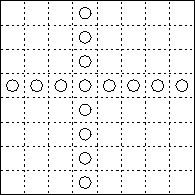



Next: Solution
Up: Alignment using Templates
Previous: Solution
The aim of this exercise is to show how Fortran 90 can be used to
program the Game of Life, a simple grid based problem with complex
behaviour. It will show how
Fortran 90 can be used to produce code in a very neat form and exposes
the potential for coding in a data parallel programming style.
The game of life is a simple cellular automata where the world is a 2D
grid of cells which have two states: alive or dead. At each iteration
the new state of a cell is determined by the state of its neighbours at
the previous iteration. This includes both the nearest neighbours and
diagonal neighbours.
The rules for the evolution of the system are:
- if a cell has exactly two alive neighbours it maintains state.
- if it has exactly three alive neighbours it is alive.
- otherwise, it is dead.
Your code will need to:
- initialise the board,
- loop,
- Print board,
- calculate number of neighbours,
- if (neighbours = 3) then live
elseif (neighbours < 2) or (neighbours > 3) then die,
- end loop.
The number of neighbours can be calculated using shifts,
target = CSHIFT(source, shift, dimension)
sets target to be the same as source but with its elements shifted a
distance shift along dimension of the array dimension. For example,
target = CSHIFT(source, -1, 1)
would set
target(i) = source(i - 1)
CSHIFT automatically performs periodic boundary conditions. Otherwise
references would be made to elements outside the bounds of the array.
The following skeleton program (which is available by clicking here) should be
used as a starting point.
PROGRAM life
IMPLICIT NONE
! This code performs MAXLOOP iterations of an NxN life board
!
INTEGER, PARAMETER :: N=8, MAXLOOP=10
INTEGER :: loop
CHARACTER(LEN=10) :: picfile
! 1) Declare main arrays
!
! 2) Initialise board
!
! Print starting config to file life00.pgm
!
WRITE(picfile, 20) 0
20 FORMAT('life', i2.2, '.pgm')
OPEN(UNIT=10, FILE=picfile)
WRITE(10, FMT='(''P2'',/,i3,2x,i3,/,i3)') N, N, 1
WRITE(10,*) board
CLOSE(UNIT=10)
! 3) Perform MAXLOOP updates
!
! 4) Count number of neighbours
!
! 5) Calculate new generation
!
! Write out new state of board
!
WRITE(picfile, 20) loop
OPEN(UNIT=10, FILE=picfile)
WRITE(10, FMT='(''P2'',/,i3,2x,i3,/,i3)') N, N, 1
WRITE(10,*) board
CLOSE(UNIT=10)
END DO
END
- Initialisation: Use array syntax to initialise a board
(an
 INTEGER array with value 1 for a live cell and 0 for a dead one) with the
following pattern, where the marked cells are alive, where N = 8 in this case. Set the row
and column nearest the centre (i.e. N/2)
INTEGER array with value 1 for a live cell and 0 for a dead one) with the
following pattern, where the marked cells are alive, where N = 8 in this case. Set the row
and column nearest the centre (i.e. N/2)

- Print board: The board can be printed either as a plain
text file using
the standard Fortran print format statements, or using the following
pieces of code can be included to produce a series of bitmaps which
can be animated using xv.
! Include in the declarations; strings for filenaming
CHARACTER (LEN=2) :: cupdate
CHARACTER (LEN=12) :: filename
!...
! Include in the time loop
! hack to write time into a string
WRITE(cupdate,'(I2.2)') update
filename = 'life'//cupdate//'.pgm'
OPEN(UNIT=10,FILE=filename)
! write the board to a pgm file for viewing
WRITE(10,fmt='(''P2'',/,I3,2X,I3,/,I3)') N, N, 1
! must be a capital P for the MAGIC NUMBER
WRITE(10,*) board
CLOSE(10)
This should, when run, produce life_*.pgm files which can be viewed using
xv. Alternatively, these files can be viewed as animation using,
xv -expand 10 -wait 0.1 -wloop -rw *.pgm
- Update: Declare an array the same size as the board
 to
contain the number of neighbours for each point. Include all nearest neighbours,
including diagonal neighbours. This update can be done using the following Fortran 90
features.
to
contain the number of neighbours for each point. Include all nearest neighbours,
including diagonal neighbours. This update can be done using the following Fortran 90
features.
- Use CSHIFT to calculate the number of neighbours. In order to
access the
diagonal neighbours you may need to used nested CSHIFT s. For example,
target = CSHIFT(CSHIFT(source, 1, 2), -1, 1)
This would shift array source initially in the 2nd dimension and then in
the 1st.
- Use WHERE to decide whether to create or kill new organisms at
each grid point.
- Compilation: Compile your code (life.f90, with a Fortran 90
compiler with, say, board size
N=8 for the test, for 10 iterations of evolution) to produce an
executable life.
- Run: and use xv to see your creations.
Now add distribution directives for the two arrays
source and target.
Go back to Notes 




Next: Solution
Up: Alignment using Templates
Previous: Solution
©University of Liverpool, 1997
Thu May 29 10:11:26 BST 1997Not for commercial use.
